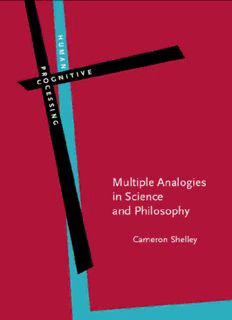Table Of Content<DOCINFOAUTHOR""TITLE"MultipleAnalogiesinScienceandPhilosophy"SUBJECT"HCP,Volume11"KEYWORDS""SIZEHEIGHT"220"WIDTH"150"VOFFSET"4">
MultipleAnalogiesinScienceandPhilosophy
humancognitiveprocessingisaforumforinterdisciplinaryresearchonthe
nature and organization of the cognitive systems and processes involved in
speaking and understanding natural language (including sign language), and
their relationship to other domains of human cognition, including general
conceptual or knowledge systems and processes (the language and thought
issue), and other perceptual or behavioral systems such as vision and non-
verbal behavior (e.g. gesture). ‘Cognition’ should be taken broadly, not only
includingthedomainofrationality,butalsodimensionssuchasemotionand
the unconscious. The series is open to any type of approach to the above
questions (methodologically and theoretically) and to research from any
discipline, including (but not restricted to) different branches of psychology,
artificialintelligenceandcomputerscience,cognitiveanthropology,linguistics,
philosophyandneuroscience.Ittakesaspecialinterestinresearchcrossingthe
boundariesofthesedisciplines.
Editors
MarceloDascal,TelAvivUniversity
RaymondW.Gibbs,UniversityofCaliforniaatSantaCruz
JanNuyts,UniversityofAntwerp
Editorialaddress
JanNuyts,UniversityofAntwerp,Dept.ofLinguistics(GER),
Universiteitsplein1,B2610Wilrijk,Belgium.
E-mail:jan.nuyts@ua.ac.be
EditorialAdvisoryBoard
MelissaBowerman,Nijmegen(cid:1);WallaceChafe,SantaBarbara,CA(cid:1);
PhilipR.Cohen,Portland,OR(cid:1);AntonioDamasio,IowaCity,IA(cid:1);
MortonAnnGernsbacher,Madison,WI(cid:1);DavidMcNeill,Chicago,IL(cid:1);
EricPederson,Eugene,OR(cid:1);FrançoisRecanati,Paris(cid:1);
SallyRice,Edmonton,Alberta(cid:1);BennyShanon,Jerusalem(cid:1);
LokendraShastri,Berkeley,CA(cid:1);DanSlobin,Berkeley,CA(cid:1);
PaulThagard,Waterloo,Ontario(cid:1)
Volume11
MultipleAnalogiesinScienceandPhilosophy
byCameronShelley
Multiple Analogies
in Science and Philosophy
Cameron Shelley
JohnBenjaminsPublishingCompany
Amsterdam(cid:1)/(cid:1)Philadelphia
TM Thepaperusedinthispublicationmeetstheminimumrequirements
8
ofAmericanNationalStandardforInformationSciences–Permanence
ofPaperforPrintedLibraryMaterials,ansiz39.48-1984.
LibraryofCongressCataloging-in-PublicationData
Shelley,Cameron
Multipleanalogiesinscienceandphilosophy / CameronShelley.
p. cm.(HumanCognitiveProcessing,issn1387–6724;v.11)
Includesbibliographicalreferencesandindexes.
1.Analogy.2.Evolution(Biology)--Philosophy.3.Archaeology--
Philosophy.4.Plato.Republic.I.Title.II.Series.
BD190. S48 2003
169-dc21 2003048153
isbn9027223637(Eur.)/1588114023(US)(Hb;alk.paper)
©2003–JohnBenjaminsB.V.
Nopartofthisbookmaybereproducedinanyform,byprint,photoprint,microfilm,or
anyothermeans,withoutwrittenpermissionfromthepublisher.
JohnBenjaminsPublishingCo.·P.O.Box36224·1020meAmsterdam·TheNetherlands
JohnBenjaminsNorthAmerica·P.O.Box27519·Philadelphiapa19118-0519·usa
JB[v.20020404] Prn:16/04/2003;9:27 F:HCP11CON.tex / p.1(116-172)
Table of contents
ListofFiguresandTables ix
Preface xiii
Acknowledgments xv
Chapter1
Theproblemofmultipleanalogies 1
1.1 Introduction 1
1.2 Analogyasinduction 4
1.3 Analogyassharedstructure 6
1.4 Overview 9
Chapter2
Multipleanalogiesand“oldfourlegs” 11
2.1 Analogiesinscience 11
2.2 SingleanalogiesintheMulticonstrainttheory 13
2.3 Analogiesinevolutionarybiology 19
2.4 Coelacanth:Thelivingfossil 20
2.5 Implicationsformultipleanalogies 24
2.5.1 Structuralconsistency 26
2.5.2 Corroboration 27
2.5.3 Abstractionandexemplification 28
2.5.4 Supplementation 29
2.5.5 Disanalogyandextension 30
2.6 Summary 31
Chapter3
MultipleanalogiesfromtheMesozoic 35
3.1 Analogiesandevolutionarytheory 35
3.2 Ceratopsians:Thehorneddinosaurs 36
3.3 Archaeopteryx:Thefirstbird 42
3.4 Implicationsformultipleanalogies 50
JB[v.20020404] Prn:16/04/2003;9:27 F:HCP11CON.tex / p.2(172-210)
Tableofcontents
3.4.1 Visualrepresentations 50
3.4.2 Evolutionaryscenarios 55
3.4.3 Fecundity 60
3.5 Summary 62
Chapter4
Multipleanalogiesinarchaeology 65
4.1 Analogiesinarchaeology 65
4.2 Peruvianpots 68
4.3 Greekfigurinelegs 71
4.4 Clovismammothharvesting 75
4.5 Implicationsformultipleanalogies 78
4.5.1 Visualimagery 79
4.5.2 Specificity 81
4.5.3 Supplementation 82
4.6 Analogiesinarchaeologicalinference 83
4.7 Summary 86
Chapter5
MultipleanalogiesinPlato’sRepublic 89
5.1 AnalogiesinPlato’sphilosophy 89
5.2 Thefunctionofthesoul 91
5.3 Healthandjustice 94
5.4 Plato’scondemnationofthepoet 97
5.5 Implicationsformultipleanalogies 102
5.5.1 Complementationandnarrativerepresentation 102
5.5.2 Specificity 105
5.5.3 Supplementation 108
5.6 Platoonmultipleanalogies 109
5.7 Summary 111
Chapter6
Modellingmultipleanalogies 113
6.1 Multipleanalogiesinperspective 113
6.2 Structuralconsistencyandindependence 114
6.3 Purposeandplanning 117
6.4 Representationalmodalities 120
JB[v.20020404] Prn:16/04/2003;9:27 F:HCP11CON.tex / p.3(210-244)
Tableofcontents
6.4.1 Verbal 120
6.4.2 Visual 121
6.4.3 Narrative 123
6.5 Processes 124
6.5.1 Abstractionandexemplification 125
6.5.2 Supplementation 126
6.5.3 Specificity 129
6.6 Philosophyofscience 130
6.6.1 Disanalogyandextension 130
6.6.2 Fecundityandtheorychange 131
6.6.3 Evolutionaryscenarios 132
6.6.4 Archaeologicalscenarios 133
6.6.5 Discoveryversusjustification 134
6.7 Concludingremarks 134
Appendix
Historicalreview 137
A.1 Plato 138
A.2 Aristotle 140
A.3 Bacon 143
A.4Mill 146
A.5 Sharedstructuretheory 149
Notes 153
References 157
Index 165
JB[v.20020404] Prn:4/03/2003;15:48 F:HCP11LFT.tex / p.1(111-206)
List of Figures and Tables
Figures
2.1 AroughphylogenyofCoelacanthspecies.Thesolidarrowsindicatethehomo-
logicalexplanationofLatimeriareproductivebiologyasinheritance(andcon-
servation) ofreproductive strategy from a hypothetical commonancestor la-
beled“Ur-Coelacanth.”TheanalogywiththesharkHexanchusisindicatedby
thedashedarrow. 23
3.1 TriceratopssquaresoffagainsttwoTyrannosaurusrex,fromamuralbyCharles
R.KnightfortheFieldMuseumofNaturalHistory,Chicago(PhotoCK9T). 37
3.2 Sample modern and fossil organisms grouped in rows according to similari-
tiesofhornshapeandstructure(Farlow&Dodson1975:357).Combatbehav-
ior (Type 1, 2, or 3) of the fossil ceratopsian may then be inferred by anal-
ogy. A, chameleon; B, rhino; C, steer; D, North American mountain goat; E,
Monoclonius;F,Torosaurus;G,Protoceratopsandrewsi.Notdrawntoscale. 38
3.3 Proavis,thehypotheticalancestorofArchaeopteryx,reconstructedbyHeilmann
(1927:200)withpatagialikethefrilledgecko.Thiscreaturealsoappearsinthe
RiteofspringsequenceoftheDisneyfilmFantasiain1940. 44
3.4 Terminalphalanges(withouthornyclaws)fromthefeetofselectedbirdtypes
comparedwiththoseoffourspecimensofArchaeopteryx(Ostrom1974:37).The
columnsdisplaythemiddle“toe”(III)andthehallux(I)ofeachbird.Thefour
Archaeopteryxfeetaremostlikethoseofgroundbirdsandunlikethoseofallthe
otherbirds,groundpredatorsinparticular.Thehorizontallinesequal5cmon
thescaleofeachclaw. 47
3.5 AvisualanalogytakenfromthefrontleafofaChristmascard.Thescenejuxta-
posessimilareventsfromtwoanalogoussequencesrepresentingthecausesand
outcomesoftransportationdifficulties. 53
3.6 RoughphylogenyofceratopsiandinosaursfromtheJudithian,Edmontonian,
and Lancian periods of the Upper Cretaceous (Farlow & Dodson 1975:354).
Thephylogenydistinguishesthreegroupsofceratopsians:a“primitive”group,
labeledAthroughCinthecentralcolumn;a“long-frilled”groupDthroughH
intheleft-handarea;a“short-frilled”groupIthroughMintheright-handarea.
LinesdisplayingphylogeneticrelationshipsweredeliberatelyomittedbyFarlow
&Dodsontoexpressuncertaintyondetailsofinheritance. 57
Description:A multiple analogy is a structured comparison in which several sources are likened to a target. In "Multiple analogies in science and philosophy", Shelley provides a thorough account of the cognitive representations and processes that participate in multiple analogy formation. Through analysis of re

